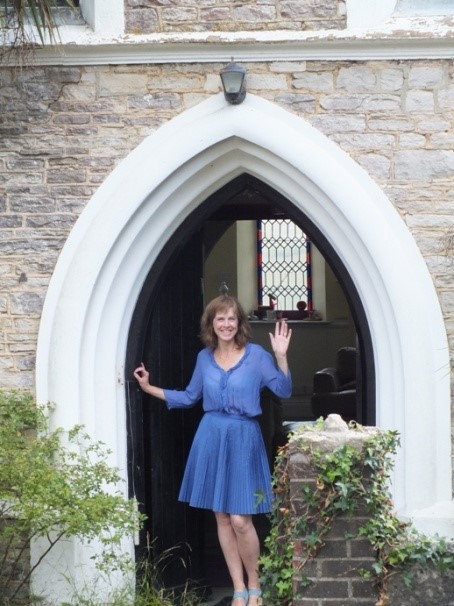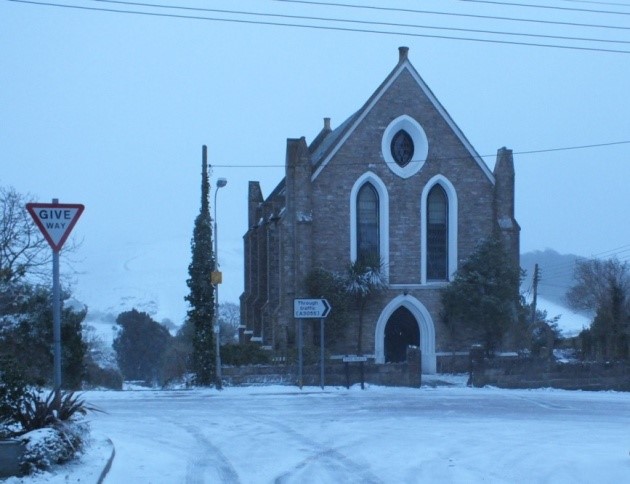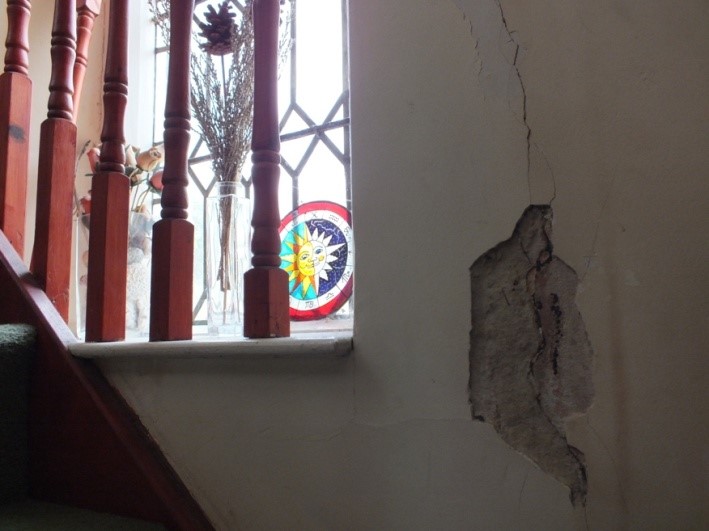What’s it like to live in an old church?


1
When I tell people my address, at the post office, say, or the voting booth, or the council offices, they sometimes gasp, ‘oh, you live there?’ And they may give breathless gestures, like ‘at the top of the hill’, ‘with the amazing views’, and ‘all the pointy, stained glass windows’, just to be clear where they mean…
We live in an Old Church. In the middle of nowhere, with hills in front and woods behind and the sea on either side, it sits at a key junction on the tourist map of the Isle of Wight; open-top busses go by in the summer and all the locals know it as a scenic short cut.
So the 1840s congregational chapel is a familiar face to many people we meet. An elderly neighbour might tell me about getting her baby weighed at the mother’s group there in the 1950s, or a new friend might confess they’d been to a youth club in the crypt in the 1970s; while the doctor’s receptionist always smiles at my files as she got married in what is now our house.
But the first time I saw it, it seemed familiar to me too; in fact, it made my heart race, almost like a shock of recognition. One evening, while we were house-hunting for the next size up nearby, I’d popped out for a pint of milk and walked to the shop a way I didn’t usually take. There was a full moon which seemed to be pulling me by a different route to the mall. Then I noticed an estate agent’s window that I hadn’t looked in before, lit by brilliant moonlight.
It sounds cheesy but when I saw the old church’s photo I fell in love, instantly. A bit like seeing my children’s faces for the first time and feeling that I already knew them; I could somehow see us living in that house already.
I remember grabbing the milk and rushing home to my husband, with my blood pounding. The old church on the Isle of Wight was at the very top of our budget, the same price as my favourite option in Southsea; a skinny Victorian villa with four bedrooms, basement kitchen and courtyard garden, close to friends and family, and the university where I work. The church was just about within cash and commuting reach; but represented a great leap of faith. Could we really live there? With two young children, and both our jobs on the mainland?
We looked around it in December 2002. It was bleak midwinter and we had to cross a grey sea to view the property. We loved it passionately, lusted after such a life-style change; but I swore to myself, very clearly, gazing through the cobwebby stained glass window on the cavernous landing: no, we can’t live here. Nobody could…

2
When I first saw the Old Church, on a winter day, on the Isle of Wight, over ten years ago, I fell in love with it. I felt strongly that it was too big, too remote, too old, too much of a church, to be a family house. But my husband stood outside with me, looking up at its stone buttresses and said (in a voice I can still hear echoing when I stand there today) he loved it, too.
Like a crush, I knew it couldn’t really happen, it wasn’t practical, it wasn’t humanly possible to live there, and go to work on a hovercraft, and still be home in time for tea. Yet we rushed back to the mainland and put our own house on the market right away, and I went to sleep every night mentally doing the interior décor, fitting and furnishing every inch of that gothic dream house. Most of those grand designs are still just dreamy fantasies a decade later!
But we didn’t buy it. Before we could sell our cute, two-bedroomed cottage in Southsea, or even had a few viewings, somebody else had put in an offer on the Old Church and it was off the market. This didn’t stop Richard and I thinking about it. We still needed to move but nothing could interest or excite us, now, except a church like that, in the exact same area. For six months, our house-buying plans included looking for land for sale close by, where we could build a replica congregational chapel from 1847. (Stranger things do happen on the IOW!)
And one day, as I sat on a bus idling at traffic lights, looking idly in an estate agent window beside us, the images on a screen changed, and there was the Old Church again. The same shot I’d seen once before, also by sheer chance, that had made my heart beat faster. Now, it seemed we had a second chance. Breathlessly, I viewed the details again, and ran home to tell my husband. Next morning we told that estate agent we would sell our house for the bare minimum price we’d need to purchase the church. Luckily, we’d found the right guy: he knew the vendor, and made a miracle sale, so that the property developer picked up our quirky townhouse for a bargain, and we took the converted chapel off his hands.
Still it was a year since we’d first seen it, and winter again, on the day we moved in. Walking towards it through the graveyard, I had that same scary feeling: nobody could live here. And walking inside the cold church (the heating wouldn’t come on till a week later), I thought: oh no, what have we done…

3
The day we moved into the Old Church, a congregational chapel built in 1847, on a green hill on the Isle of Wight, with views of the sea on both sides, I panicked. It was the moment I’d been dreaming of for over a year; but I wished we could stay at my mum’s, where we’d lodged during the move, in warmth and familiar comfort. Not just for me, but for the children, aged six and four, who were about to leave their sunny suburb for a gothic outbuilding, a ferry ride away. And it was February.
But by the time I lay in bed that night, watching clouds of my breath reach the high vaulted ceiling, almost gasping in excitement to be there, I thought to myself: ‘this is it now. We’re finally here. The only way I’ll leave this house is in my coffin.’
My husband didn’t feel quite the same way. He wasn’t familiar with the area already (I’d stayed in the caravan site at nearby Whitecliff Bay since the year dot) and he had the harder commute. I took the car, did the school run, hopped on a hovercraft, and walked to my office. He had to go by train and boat and train again, taking ages. I remember watching him wake up smiling one morning, on the futon from his student flat now looking too small in the master bedroom, and realise where he was (the middle of nowhere) with a sigh.
By spring, he had got on a bike, though, and his commute was more pleasurable: a bracing run down a winding, tree-arched road, to a fun-packed ferry ride with a merry band of fellow cyclists. Richard’s not the kind of guy for a traditional tube ride into work, eye-to-eye with a stranger who’s pretending he doesn’t exist. He’d get the regulars talking and laughing like they do between the stops at Ryde Pier Head and Portsmouth Harbour.
So one moment we were having the ‘look, let’s give it six months and if it’s not working we’ll move back to the mainland’ talk; and then it didn’t come up again, till nine months later, at Richard’s 40th birthday party. Old friends and new found their way to ‘the middle of nowhere’ in the dark, in early December: and I realised, in a happy (drunken) haze, that he was raving about our life on the island to everyone who asked him.
My fortieth birthday was not till three years later. We still raved about living our dream: but at my party, with a sudden ‘déjà vu’, I realised that I had actually dreamed about the old church, a decade before… I remembered the exact scene; that house, in that place, with those people; as if it had been calling me to come, in my sleep…